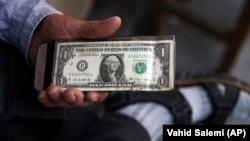The exchange rate of the U.S. dollar and other major currencies once again skyrocketed in Iran and reached the highest level in past thirty days, reports from the local free market say.
One U.S. dollar was exchanged for 152,000 rials at exchange bureaus on Wednesday, October 31 which was record breaking for the current Iranian calendar month (September 23-October 22).
Meanwhile, one euro was exchanged for +170,300 rials and the price of gold coin reached to fifty million rials mark.
State-run Iran Labor News Agency (ILNA) cited economists and dealers as saying that the looming second batch of US sanctions over Iran and speculation on increased demand for foreign currencies have set the stage for a rise in value of foreign currencies.
Khorasan daily has also attributed the 47.5 percent price rise for basic goods in a single month ending Oct. 20, to the looming U.S. sanctions, beginning November 4.
Washington has announced that the second batch of its renewed sanctions against the Islamic Republic will be imposed on November 4, mainly aiming Iranian oil exports and Central Bank of Iran (CBI).
U.S. Treasury Secretary Steve Mnuchin says that Washington has decided to bring down Iranian oil exports to zero, forcing Tehran to change its behavior.
Mnuchin who met Israeli Prime Minister Benjamin Netanyahu and Saudi Arabia's Crown Prince and strongman, Mohammad bin Salman last week and discussed the implementation of the second batch of sanctions on Tehran, told Reuters Sunday, October 21, that in order to avoid consequences countries will have to substantially reduce their Iranian oil imports.
“I would expect that if we do give waivers it will be significantly larger reductions,” Mnuchin told Reuters in Jerusalem at the start of a Middle East trip.
Mnuchin also dismissed concerns that oil prices could spike if international markets are deprived of Iranian production.
In the meantime, ILNA argued that a significant increase in inflation rate and its expected further increase in the near future have helped foreign currencies to rise again.
By hoarding gold and dollar, people in Iran are struggling to keep the value of their assets, ILNA noted.
Last Thursday, CBI said that inflation and year-to-year inflation rates in month of Mehr (September 23-October 22) reached to 15.9% and 36.9% respectively.
Meanwhile, according to ISNA, state-owned banks started to pay more for a dollar on Wednesday, comparing to what they offered at the beginning of the week.
Banks have increased their rates for buying dollars and euros and currently pay 119,000 rials for one dollar, and 134,900 rials for one euro. These are foreign currencies that exporters bring bank to the country and sell it to state banks.
As the psychological impact of sanctions and a deteriorating economy deepens, Iranian leaders try to appear defiant and attempt to boost morale.
U.S. efforts are “definitely doomed to failure thanks to our great nation’s spirit of resistance,” Mr. Rouhani declared on Oct. 23.



